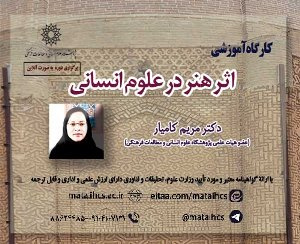گزارش عملیات حفاظت و مرمت نعلین کعبه موزه فرش ایران
آرشیو
چکیده
نعلین کعبه موزه فرش ایران یک جفت کفش فلز آلیاژ مس اثر استاد پرویز تناولی در فضای روباز است. این اثر به عنوان جزیی از یادمان کعبه در سبک ساده گرایی مینیمالیسم در محوطه موزه فرش ایران ساخته شده است. اندازه نعلین در مقیاس واقعی خلق شده است. روی سطح نعلین به وسیله شیارهای ریز و ظریفی به منظور القای حس زیبایی شناسانه و جلوی بصری بافت دار شده است. همچنین یک پاتین هنری تیره رنگ بر روی سطح اثر توسط هنرمند ایجاد شده است داخل نعلین محل تجمع گرد و غبار خس و خاشاک فضای سبز محیط پیرامون بوده است. علاوه بر این طی سالیان متمادی و ارتباط با زمین تحت تاثیر شرایط جوی مانند بارندگی های سالیانه اختلاف دمای در فصل مختلف سال و آلاینده های محیط شهری همچون بارانهای اسیدی قرار گرفته است. سطح نعلین با محصولات خوردگی سبز رنگ و رسوبات کربناتی شکل مخدوش شده است. همچنین در رسوبات سبز رنگ یون کلر به عنوان عامل بیماری برنز به حضور نانتوکیت و هیدروکسی کلریدهای مس همچون آتا کامیت پارا تا کامیت کلینو آتاکامیت و بوتالاکیت با خوردگی فعال آلیاژهای مس مرتبط می باشد. هدف از این عملیات حفظ پایداری و جلوگیری از قرارگیری بیشتر در برابر عوامل آسیب رسان محیط شهری تعریف شده است. به منظور ارزیابی و مستندنگاری وضعیت موجود اثر عکس برداری دیجیتال در مقیاس ماکروسکوپی و میکروسکوپی صورت گرفته است. به منظور پاکسازی و حذف رسوبات سطحی از روش های مکانیکی توسط اسکالپ و دستگاه التراسونیک بهره گرفته شده و از روش ضمادگذاری برای حذف رسوبات حجیم از محلول نمک راشل و اسید کلریدریک ۲ به صورت موضعی کنترل شده و محدود استفاده شد. به منظور ایجاد بازدارندگی سطح از محلول ۳ BTA و به عنوان پوشش دهنده سطحی اثر از محلول اپوکسی پلی آمید استفاده شده است.Conservation and Restoration Operations of the Metal Clogs of the Iran Carpet Museum
The "Clogs of the Kaaba" at the Iran Carpet Museum is a pair of metal/ copper alloy shoes by Parviz Tanavoli for an outdoor installation. The work is part of a memorial chapel designed minimalist style within the museum’s grounds. The clogs are crafted to a life-size scale, with their surfaces textured with fine and delicate grooves to enhance their aesthetic and visual appeal. The artist has also applied a dark artistic patina to the surface of the clogs. The interior of the clogs has accumulated dust, soot, and debris from the surrounding greenery. Additionally, prolonged exposure to environmental conditions such as annual rainfall, seasonal temperature variations, and urban pollutants such as acid rain has affected their condition on the ground. The surface of the clogs shows green corrosion products and carbonate deposits. the aim of this operation is to stabilize the clogs and prevent further exposure to harmful urban environmental factors. In order to evaluate and document the current condition, digital photography was conducted on both a macroscopic and microscopic scales. Surface sediment removal was carried out using manual mechanical methods with a scalpel and ultrasonic device. The poultice method was applied in a controlled and limited manner to remove thick sediments using Rachel's salt solution and%2 hydrochloric acid. To protect the surface, a %3 BTA (benzotiazol: C6H5N3) solution was used, followed by a coating of epoxy polyamide solution.
Clogs of the Kaaba,Conservation,Corrosion,Copper alloys,


